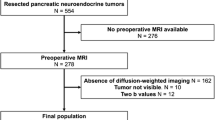Abstract
Purpose
To explore the role of histogram analysis of apparent diffusion coefficient (ADC) MRI maps based on entire tumor volume data in determining pancreatic neuroendocrine tumor (PNT) grade.
Methods and Materials
Retrospective evaluation of 22 patients with PNTs included low-grade (G1; n = 15), intermediate-grade (G2; n = 4), and high-grade (G3; n = 3) tumors. Regions of interest containing the lesion were drawn on every section of the ADC map containing the tumor and summated to obtain histograms for entire tumor volume. Calculated histographic parameters included mean ADC (mADC), 5th percentile ADC, 10th percentile ADC, 25th percentile ADC, 50th percentile ADC, 75th percentile ADC (ADC75), 90th percentile ADC (ADC90) and 95th percentile ADC (ADC95), skewness and kurtosis. Histogram parameters were correlated with tumor grade by repeated measures analysis of variance with Tukey–Kramer post hoc comparisons.
Results
The mADC, ADC75, ADC90, and ADC95 were significantly higher in G1 tumors (1283 ± 267; 1404 ± 300; 1495 ± 318; 1562 ± 347 × 10−6 mm2/s) compared to G2 (892 ± 390; 952 ± 381; 1036 ± 384; 1072 ± 374 × 10−6 mm2/s) and to G3 tumors (733 ± 225; 864 ± 284; 1008 ± 288; 1152 ± 192 × 10−6 mm2/s) (p value <0.05). Skewness and kurtosis were significantly different between G1 (0.041 ± 0.466; 2.802 ± 0.679) and G3 (1.01 ± 1.140; 5.963 ± 4.008) tumors (p value <0.05). Tumor volume (mL) was significantly higher on G3 (55 ± 15.7) compared to G1 (1.9 ± 2.7) and G2 (4.5 ± 3.6) tumors (p value <0.05). In this small sample size, we did not detect statistically significant parameters between G2 (n = 4) and G3 (n = 3) tumors.
Conclusions
Histographic analysis of ADC maps on the basis of the entire tumor volume can be useful in differentiating histologic grades of PNTs.



Similar content being viewed by others
References
Zhou C, Zhang J, Zheng Y, Zhu Z (2012) Pancreatic neuroendocrine tumors: a comprehensive review. Int J Cancer 131(5):1013–1022
Fraenkel M, Kim MK, Faggiano A, Valk GD (2012) Epidemiology of gastroenteropancreatic neuroendocrine tumours. Best Pract Res Clin Gastroenterol 26(6):691–703
Turaga KK, Kvols LK (2011) Recent progress in the understanding, diagnosis, and treatment of gastroenteropancreatic neuroendocrine tumors. CA Cancer J Clin 61(2):113–132
Piani C, Franchi GM, Cappelletti C, et al. (2008) Cytological Ki-67 in pancreatic endocrine tumours: an opportunity for pre-operative grading. Endocr Relat Cancer 15(1):175–181
Reid MD, Balci S, Saka B, Adsay NV (2014) Neuroendocrine tumors of the pancreas: current concepts and controversies. Endocr Pathol 25(1):65–79
Plockinger U, Rindi G, Arnold R, et al. (2004) Guidelines for the diagnosis and treatment of neuroendocrine gastrointestinal tumours. A consensus statement on behalf of the European Neuroendocrine Tumour Society (ENETS). Neuroendocrinology 80(6):394–424
Oberg K, Kvols L, Caplin M, et al. (2004) Consensus report on the use of somatostatin analogs for the management of neuroendocrine tumors of the gastroenteropancreatic system. Ann Oncol 15(6):966–973
Pape UF, Jann H, Muller-Nordhorn J, et al. (2008) Prognostic relevance of a novel TNM classification system for upper gastroenteropancreatic neuroendocrine tumors. Cancer 113(2):256–265
Yamaguchi T, Fujimori T, Tomita S, et al. (2013) Clinical validation of the gastrointestinal NET grading system: Ki67 index criteria of the WHO 2010 classification is appropriate to predict metastasis or recurrence. Diagn Pathol 8:65
Ramage JK, Ahmed A, Ardill J, et al. (2012) Guidelines for the management of gastroenteropancreatic neuroendocrine (including carcinoid) tumours (NETs). Gut 61(1):6–32
Schmid-Tannwald C, Oto A, Reiser MF, Zech CJ (2013) Diffusion-weighted MRI of the abdomen: current value in clinical routine. J Magn Reson Imaging 37(1):35–47
Bakir B, Salmaslioglu A, Poyanli A, Rozanes I, Acunas B (2010) Diffusion weighted MR imaging of pancreatic islet cell tumors. Eur J Radiol 74(1):214–220
Wang Y, Chen ZE, Yaghmai V, et al. (2011) Diffusion-weighted MR imaging in pancreatic endocrine tumors correlated with histopathologic characteristics. J Magn Reson Imaging 33(5):1071–1079
Bull JG, Saunders DE, Clark CA (2012) Discrimination of paediatric brain tumours using apparent diffusion coefficient histograms. Eur Radiol 22(2):447–457
Kang Y, Choi SH, Kim YJ, et al. (2011) Gliomas: Histogram analysis of apparent diffusion coefficient maps with standard- or high-b-value diffusion-weighted MR imaging—correlation with tumor grade. Radiology 261(3):882–890
Ahn SJ, Choi SH, Kim YJ, et al. (2012) Histogram analysis of apparent diffusion coefficient map of standard and high B-value diffusion MR imaging in head and neck squamous cell carcinoma: a correlation study with histological grade. Acad Radiol 19(10):1233–1240
Hayashida Y, Hirai T, Morishita S, et al. (2006) Diffusion-weighted imaging of metastatic brain tumors: comparison with histologic type and tumor cellularity. AJNR Am J Neuroradiol 27(7):1419–1425
Heo SH, Shin SS, Kim JW, et al. (2013) Pre-treatment diffusion-weighted MR imaging for predicting tumor recurrence in uterine cervical cancer treated with concurrent chemoradiation: value of histogram analysis of apparent diffusion coefficients. Korean J Radiol 14(4):616–625
Downey K, Riches SF, Morgan VA, et al. (2013) Relationship between imaging biomarkers of stage I cervical cancer and poor-prognosis histologic features: quantitative histogram analysis of diffusion-weighted MR images. AJR Am J Roentgenol 200(2):314–320
Brenner R, Metens T, Bali M, Demetter P, Matos C (2012) Pancreatic neuroendocrine tumor: added value of fusion of T2-weighted imaging and high b-value diffusion-weighted imaging for tumor detection. Eur J Radiol 81(5):e746–e749
Dale BM, Braithwaite AC, Boll DT, Merkle EM (2010) Field strength and diffusion encoding technique affect the apparent diffusion coefficient measurements in diffusion-weighted imaging of the abdomen. Invest Radiol 45(2):104–108
Bender R, Lange S (2001) Adjusting for multiple testing—when and how? J Clin Epidemiol 54(4):343–349
Kumar R, Indrayan A (2011) Receiver operating characteristic (ROC) curve for medical researchers. Indian Pediatr 48(4):277–287
Author information
Authors and Affiliations
Corresponding author
Rights and permissions
About this article
Cite this article
Pereira, J.A.S., Rosado, E., Bali, M. et al. Pancreatic neuroendocrine tumors: correlation between histogram analysis of apparent diffusion coefficient maps and tumor grade. Abdom Imaging 40, 3122–3128 (2015). https://doi.org/10.1007/s00261-015-0524-7
Published:
Issue Date:
DOI: https://doi.org/10.1007/s00261-015-0524-7




